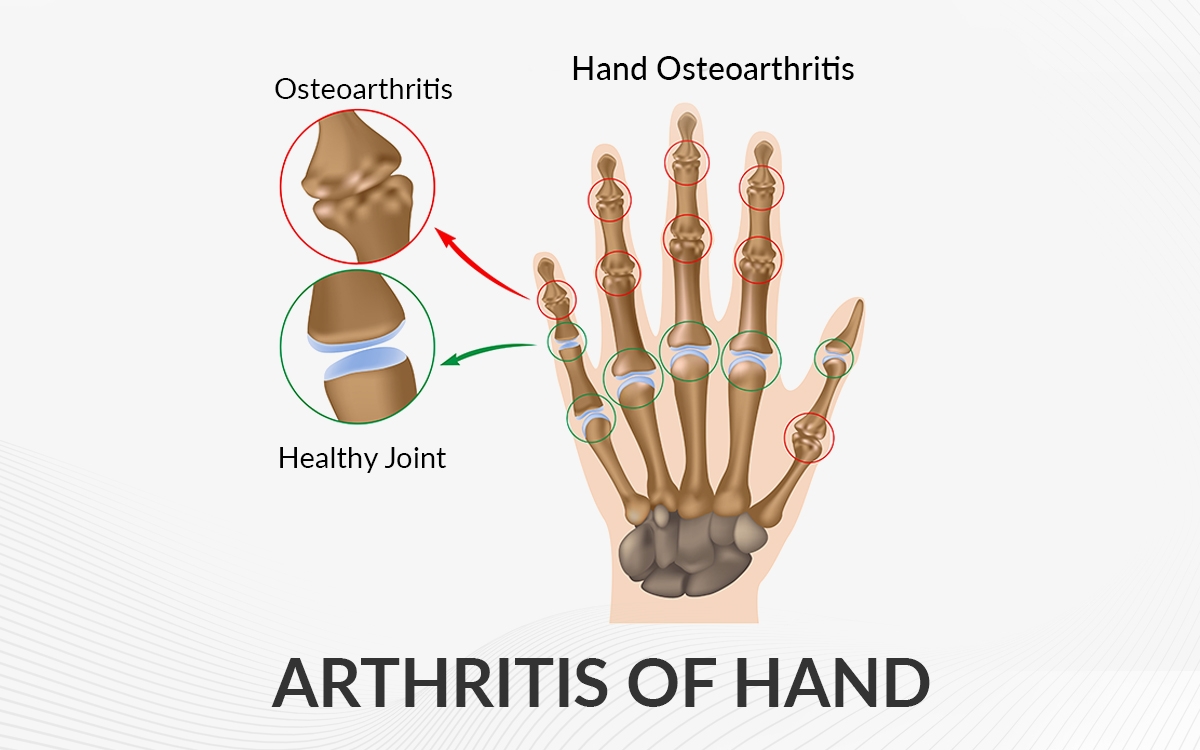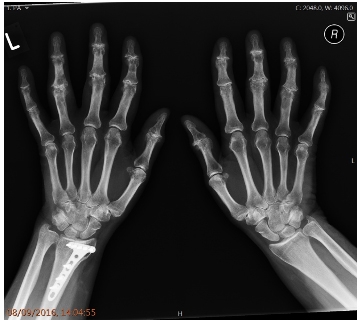
Summary
Causes
- Articular cartilage deterioration
- Ageing
- Injuries like broken finger bones or dislocated bones
- Joint problems including infections, damage to ligaments and overuse
Symptoms
- Pain and stiffness in the hand
- Clicking and cracking of fingers
- Weakness in the hand
- Swelling and redness around the joints
- Bony bumps in finger joints
- Cysts near fingertip joints
- Change in the shape of joints
Diagnosis
- Examination of the hand
- X rays or CT scans
Treatment
- Non-Operative
- Anti-inflammatories
- Local anaesthetics and steroid injections
- Splinting of the affected joints
- Surgery
- Joint fusion
- Joint replacement
What is Arthritis of the Hand?
Our hand and wrist are formed of multiple small joints that work together and produce complex composite motions including fine motions, for example, tying a shoelace, button a shirt or thread a needle.
Healthy joints have a smooth slippery tissue known as articular cartilage which covers the ends of bones and provides a smooth gliding surface for the joints. Arthritis occurs when the smooth slippery cartilage begins to wear away and these bones then rub against each other resulting in friction and joint damage. This will cause further pain, limited motion and affects activities of daily living.
There are two main types of arthritis namely osteoarthritis and rheumatoid arthritis. Osteoarthritis is more common and usually happens in three places.
- The base of the thumb where it meets your wrist
- One of the joints closest to your fingertips
- The middle joint of a finger
Without treatment, osteoarthritis gets worse over time and affects your daily function. It is important to get the diagnosis and a treatment plan as soon as possible.
What causes Hand Osteoarthritis (OA)?
On the ends of your bones there is a layer of smooth slippery material known as cartilage. It helps cushion your joints and allows them to slide easily. Overtime the cartilage gets worn down and the bones start rubbing against each other causing the symptoms of osteoarthritis (OA).
Certain factors can make you more likely to have hand OA, for example
Age – The older you are the higher your odds
Sex – Compared to men, women are twice as likely to get it
Injuries – This includes broken finger bones or dislocated bones
Joint problems – This includes infections, damage to ligaments, overuse etc.
What are the symptoms of Hand Osteoarthritis?
Most common symptoms are pain and stiffness which may become worse over time. This can affect daily activities of living and function. Stiffness can stop you from bending your finger joints all the way.
Other symptoms include clicking, cracking (Crepitus), weakness in the hand, swelling and redness because of inflammation around your joints.
You may also notice bony bumps in your finger joints. You can also get cysts which are bumps filled with fluid near your fingertip joints. Other physical changes include a change in the shape of your joints, and they become deformed.
Diagnosis of Hand Osteoarthritis?
Your doctor will take a detailed history and ask you about your symptoms and family history. He will examine your hands and do investigations like x rays or a CT scan. He may also do a blood test to rule out other causes of painful joints like rheumatoid arthritis (RA).
What is the treatment for Hand Osteoarthritis?
The treatment will be determined based on your age, activity level, how far arthritis has progressed, other medical conditions and your personal goals.
Non-surgical treatment includes anti-inflammatories which can treat the symptoms but cannot restore the joint cartilage or reverse the joint damage. This can be combined with local anaesthetic and a steroid injection which can provide pain relief for weeks to months. This is usually combined with splinting of the affected joints. The splint helps to ease the stress that is placed on it from frequent daily use. If non-operative treatment doesn’t work then surgery is usually recommended.
Surgical treatment will be tailored to your individual needs and the goal will be to provide long term pain relief and a good function to the finger joints of your hand. Surgical options will be discussed with you and a fusion (arthrodesis) or a joint replacement will be offered to you.
Joint fusion provides pain relief but will stop joint motion. As the damaged joint surfaces are fused, they cannot cause pain but the fused joint will no longer move. Joint fusion is usually offered for the joint close to the fingertip but can be offered for other joints in the hand.
The aim of joint replacement will be to provide pain relief and restore function to the joint like in a hip or a knee replacement. A joint replacement is usually offered for the middle joint of the finger and the base joint of the thumb.
What will happen after surgery?
Depending on the nature of surgery either you will go home the same day or the next. You will be referred to a trained hand therapist who may provide you with a post-operative splint to protect the hand whilst it heals. You will be given pain medication.
The length of recovery time will depend on the nature of surgery. You can usually go back to driving between four and six weeks and it takes roughly three months after major joint reconstruction for you to return to most of your daily activities.
Are there any risks of surgery?
On the whole patients have excellent pain relief and they resume good function. There are small risks (less than 5%) like infection, damage to digital nerves, vessels and tendons, stiffness, non- union, dislocation. It is an excellent operation to have with a predictable outcome and good patient satisfaction.
BMI Chelsfield Park Hospital
Bucks Cross Road Chelsfield ORPINGTON BR6 7RG
01689 877855
BMI The Blackheath Hospital
40-42 Lee Terrace Blackheath LONDON SE3 9UD
020 8318 7722
BMI The Sloane Hospital
125 Albemarle Road BECKENHAM BR3 5HS
020 8466 4000
Princess Royal University Hospital
Farnborough Common ORPINGTON BR6 8ND
01689 863223





